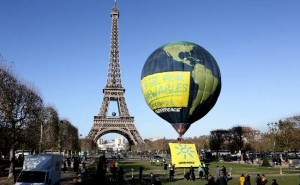 #PARIS/ #France : #World leaders will launch an ambitious attempt on Monday to hold back the earth’s rising temperatures, urging each other to find common cause in two weeks of bargaining meant to steer the global economy away from dependence on fossil fuels.
#PARIS/ #France : #World leaders will launch an ambitious attempt on Monday to hold back the earth’s rising temperatures, urging each other to find common cause in two weeks of bargaining meant to steer the global economy away from dependence on fossil fuels.
Warnings from climate scientists, demands from activists and exhortations from religious leaders like Pope Francis, coupled with major advances in cleaner energy sources like solar power, have all added to pressure to cut the carbon emissions held responsible for warming the planet.
Most scientists say failure to agree on strong measures in Paris would doom the world to ever-hotter average temperatures, bringing with them deadlier storms, more frequent droughts and rising sea levels as polar ice caps melt.
Facing such alarming projections, the leaders of more than 150 countries responsible for about 90 percent of the world’s greenhouse gas emissions have come bearing pledges to reduce their national carbon output, though by different degrees.
Achieving an international agreement committing both rich and developing nations to the fight against global warming would mean “we can have confidence that we’re doing right by future generations,” U.S. President Barack Obama said earlier this month.
On the eve of the summit, hundreds of thousands of people from Australia to Paraguay joined the biggest day of climate change activism in history, telling world leaders there was “No Planet B” in the fight against global warming.
French police detained scores of protesters after violent clashes in the centre of Paris. The police fired tear gas to disperse about 200 protesters, some of them masked, who responded by hurling rocks and candles at them.
The leaders will gather in a vast conference centre at the Le Bourget airfield near the spot where Charles Lindbergh landed his Spirit of St. Louis aircraft in 1927 after making the first solo trans-Atlantic flight, a feat that helped bring nations closer.
Whether a similar spirit of unity can be incubated in Le Bourget this time is uncertain. In all, 195 countries are part of the unwieldy negotiating process, espousing a variety of leadership styles and ideologies that has made consensus elusive in the past. Key issues, notably how to divide the global bill to pay for a shift to renewable energy, are still contentious.
Signalling their determination to resolve the most intractable points, senior negotiators sat down on Sunday, a day earlier than originally planned, to begin thrashing out an agreement.
The last attempt to get a global deal collapsed in chaos and acrimony in Copenhagen in 2009. It ended with Obama forcing his way on the gathering’s last day into a closed meeting of China and other countries, emerging with a modest concession to limit rising emissions until 2020 that they attempted to impose on the rest of the world.
Anxious to avoid a re-run of the Copenhagen disaster, major powers have tried this time to smooth some of the bumps in the way of an agreement before they arrive.
For one thing, the presidents, prime ministers and princes will make their cameo appearances at the outset of the conference rather than swooping in at the end.
Arriving in a sombre city where security has been tightened after Islamist militant attacks that killed 130 people on Nov. 13, each leader will be allowed a brief opening speech, just a few minutes long. The goal is to build momentum for consensus and avoid the messiness of past talks when diplomats put off the hard political choices until their bosses arrived.
NEW APPROACH
But there are other significant changes in approach.
The old goal of seeking a legally binding international treaty, certain to be dead on arrival in the Republican-controlled U.S. Congress, has been replaced by a system of national pledges to reduce emissions, some presented as best intentions, others legally enforced by domestic laws and regulations.
The biggest difference may be the partnership between the United States and China. The world’s two biggest carbon emitters, once on opposite sides on climate issues, agreed in 2014 to jointly kick-start a transition away from fossil fuels, each at their own speed and in their own way.
That partnership has been a balm for the main source of tension that characterised previous talks, in which the developing world argued that countries which grew rich by industrialising on fossil fuels should pay the cost of shifting all economies to a renewable energy future.
Now even China, once a leading voice of that club, has agreed to contribute to an internationally administered Green Climate Fund that hopes to dispense $100 billion a year after 2020 as a way to finance the developing world’s shift towards renewables.
If emerging with a signed deal now appears likely, so too is the prospect that it will not be enough to prevent the world’s average temperature from rising beyond 2 degrees Celsius (3.6 Fahrenheit) above pre-industrial levels. That is widely viewed as a threshold for dangerous and potentially catastrophic changes in the planet’s climate system.
Instead, the summit will produce a “long-term framework” for additional reductions down the road, Obama said in a Facebook posting before leaving Washington on Sunday, with “targets set by each nation, but transparent enough to be verified by other nations.”
How and when nations should review their goals – and then set higher, more ambitious ones – must still be hammered out.
One sign of optimism: Indian Prime Minster Narendra Modi, a key player because of his country’s size and its heavy dependence on coal, planned to use his appearance on Monday to announce an international solar alliance of more than 100 sun-kissed countries, with the aim of raising India’s profile on solar power.reuters
Leave a Reply